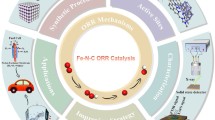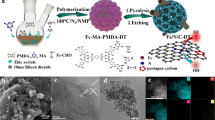Abstract
In recent years, non-noble metal catalysts such as Fe–N–C have received a lot of interest due to their excellent oxygen reduction (ORR) activity. However, the active sites of Fe–N–C still need to be further improved. Here, by adopting Lewis doping and double nitrogen source strategies to increase the density of accessible active sites, the catalyst exhibits excellent ORR activity. The ORR half-wave potential (E1/2) in 0.1 mol/L KOH solution can reach 0.92 V (vs. RHE), and the maximum power density of the Zn–air battery with Fe–N–C@MA-950 as the air electrode can reach 220 mW cm−2. The strategies provide a novel approach to the design of carbon-based catalysts for efficient energy conversion.







Similar content being viewed by others
Data and code availability
The data that support the findings of this study are available from the corresponding author, [Qinghong Huang], upon reasonable request.
References
Shang H, Zhou X, Dong J, Li A, Zhao X, Liu Q, Lin Y, Pei J, Li Z, Jiang Z, Zhou D, Zheng L, Wang Y, Zhou J, Yang Z, Cao R, Sarangi R, Sun T, Yang X, Zheng X, Yan W, Zhuang Z, Li J, Chen W, Wang D, Zhang J, Li Y (2020) Engineering unsymmetrically coordinated Cu-S1N3 single atom sites with enhanced oxygen reduction activity. Nat Commun 11(1):3049
Wan C, Duan X, Huang Y (2020) Molecular design of single-atom catalysts for oxygen reduction reaction. Adv Energy Mater 10(14):1903815
Cui J, Chen Q, Li X, Zhang S (2021) Recent advances in non-precious metal electrocatalysts for oxygen reduction in acidic media and PEMFCs: an activity, stability and mechanism study. Green Chem 23(18):6898–6925
Shen H, Thomas T, Rasaki SA, Saad A, Hu C, Wang J, Yang M (2019) Oxygen reduction reactions of Fe–N–C catalysts: current status and the way forward. Electrochem Energy Rev 2(2):252–276
Kocha SS, Shinozaki K, Zack JW, Myers DJ, Kariuki NN, Nowicki T, Stamenkovic V, Kang Y, Li D, Papageorgopoulos D (2017) Best practices and testing protocols for benchmarking orr activities of fuel cell electrocatalysts using rotating disk electrode. Electrocatalysis 8(4):366–374
Liu K, Chen P, Sun Z, Chen W, Zhou Q, Gao X (2023) The atomic interface effect of single atom catalysts for electrochemical hydrogen peroxide production. Nano Res 16(8):10724–10741
Liu K, Fu J, Lin Y, Luo T, Ni G, Li H, Lin Z, Liu M (2022) Insights into the activity of single-atom Fe-N-C catalysts for oxygen reduction reaction. Nat Commun 13(1):2075
Wang XX, Swihart MT, Wu G (2019) Achievements, challenges and perspectives on cathode catalysts in proton exchange membrane fuel cells for transportation. Nat Catal 2(7):578–589
Zhang Y, Tao L, Xie C, Wang D, Zou Y, Chen R, Wang Y, Jia C, Wang S (2020) Defect engineering on electrode materials for rechargeable batteries. Adv Mater 32(7):e1905923
Tian X, Lu XF, Xia BY, Lou XW (2020) Advanced electrocatalysts for the oxygen reduction reaction in energy conversion technologies. Joule 4(1):45–68
Luo X, Ma H, Ren H, Zou X, Wang Y, Li X, Shen Z, Wang Y, Cui L (2021) Controllable synthesis of nitrogen-doped carbon containing Co and Co3Fe7 nanoparticles as effective catalysts for electrochemical oxygen conversion. J Colloid Interface Sci 590:622–631
Mazzucato M, Gavioli L, Balzano V, Berretti E, Rizzi GA, Badocco D, Pastore P, Zitolo A, Durante C (2022) Synergistic effect of Sn and Fe in Fe-N(x) site formation and activity in Fe-N-C catalyst for ORR. ACS Appl Mater Interfaces 14(49):54635–54648
Jiang R, Qiao Z, Xu H, Cao D (2023) Defect engineering of Fe-N-C single-atom catalysts for oxygen reduction reaction. Chin J Catal 48:224–234
Wang W, Jia Q, Mukerjee S, Chen S (2019) Recent insights into the oxygen-reduction electrocatalysis of Fe/N/C materials. ACS Catal 9(11):10126–10141
Roh J, Cho A, Kim S, Lee K-S, Shin J, Choi JS, Bak J, Lee S, Song D, Kim E-J, Lee C, Uhm YR, Cho Y-H, Han JW, Cho E (2023) Transformation of the active moiety in phosphorus-doped fe–n–c for highly efficient oxygen reduction reaction. ACS Catal 13:9427–9441
Wang Y, Wang D, Li Y (2021) Rational design of single-atom site electrocatalysts: from theoretical understandings to practical applications. Adv Mater 33(34):e2008151
Sahraie NR, Kramm UI, Steinberg J, Zhang Y, Thomas A, Reier T, Paraknowitsch JP, Strasser P (2015) Quantifying the density and utilization of active sites in non-precious metal oxygen electroreduction catalysts. Nat Commun 6:8618
Mazzucato M, Gavioli L, Balzano V, Berretti E, Rizzi GA, Badocco D, Pastore P, Zitolo A, Durante C (2022) Synergistic effect of Sn and Fe in Fe–Nx site formation and activity in Fe–N–C catalyst for ORR. ACS Appl Mater Interfaces 14(49):54635–54648
Zhang H, Hwang S, Wang M, Feng Z, Karakalos S, Luo L, Qiao Z, Xie X, Wang C, Su D, Shao Y, Wu G (2017) Single atomic iron catalysts for oxygen reduction in acidic media: particle size control and thermal activation. J Am Chem Soc 139(40):14143–14149
Wang D, Li B, Tao X, Rao S, Li J, Wang W, Yang J, Zhou Y (2021) Atomically dispersed iron atoms on nitrogen-doped porous carbon catalyst with high density and accessibility for oxygen reduction. J Electroanal Chem 898:115627
Wang J, Huang Z, Liu W, Chang C, Tang H, Li Z, Chen W, Jia C, Yao T, Wei S, Wu Y, Li Y (2017) Design of N-coordinated dual-metal sites: a stable and active Pt-Free catalyst for acidic oxygen reduction reaction. J Am Chem Soc 139(48):17281–17284
Zhao M, Liu H, Zhang H, Chen W, Sun H, Wang Z, Zhang B, Song L, Yang Y, Ma C, Han Y, Huang W (2021) A pH-universal ORR catalyst with single-atom iron sites derived from a double-layer MOF for superior flexible quasi-solid-state rechargeable Zn–air batteries. Energy Environ Sci 14(12):6455–6463
Li B, Shi C, Zhao N, Liu E (2023) Hydrogen-bond-promoted ORR mechanism in P-doped Fe–N–C materials. J Phys Chem C 127(2):1023–1031
Chen G, Liu P, Liao Z, Sun F, He Y, Zhong H, Zhang T, Zschech E, Chen M, Wu G, Zhang J, Feng X (2020) Zinc-mediated template synthesis of Fe-N-C electrocatalysts with densely accessible Fe-Nx active sites for efficient oxygen reduction. Adv Mater 32(8):e1907399
Li P, Ding X, Yang Z, Chen M, Wang M, Wang X (2017) Electrochemical synthesis and characterization of polyaniline-coated PEMFC metal bipolar plates with improved corrosion resistance. Ionics 24(4):1129–1137
Wang ZL, Sun K, Henzie J, Hao X, Li C, Takei T, Kang YM, Yamauchi Y (2018) Spatially confined assembly of monodisperse ruthenium nanoclusters in a hierarchically ordered carbon electrode for efficient hydrogen evolution. Angew Chem Int Ed Engl 57(20):5848–5852
Feng Q, Zhao S, Xu Q, Chen W, Tian S, Wang Y, Yan W, Luo J, Wang D, Li Y (2019) Mesoporous nitrogen-doped carbon-nanosphere-supported isolated single-atom Pd catalyst for highly efficient semihydrogenation of acetylene. Adv Mater 31(36):e1901024
You C, Zen X, Qiao X, Liu F, Shu T, Du L, Zeng J, Liao S (2015) Fog-like fluffy structured N-doped carbon with a superior oxygen reduction reaction performance to a commercial Pt/C catalyst. Nanoscale 7(8):3780–3785
Luo F, Roy A, Silvioli L, Cullen DA, Zitolo A, Sougrati MT, Oguz IC, Mineva T, Teschner D, Wagner S, Wen J, Dionigi F, Kramm UI, Rossmeisl J, Jaouen F, Strasser P (2020) P-block single-metal-site tin/nitrogen-doped carbon fuel cell cathode catalyst for oxygen reduction reaction. Nat Mater 19(11):1215–1223
Wan X, Liu X, Li Y, Yu R, Zheng L, Yan W, Wang H, Xu M, Shui J (2019) Fe–N–C electrocatalyst with dense active sites and efficient mass transport for high-performance proton exchange membrane fuel cells. Nat Catal 2(3):259–268
Koyuturk B, Farber EM, Wagner FE, Fellinger T-P, Eisenberg D (2022) A simple decagram-scale synthesis of an atomically dispersed, hierarchically porous Fe–N–C catalyst for acidic ORR. J Mater Chem A 10(37):19859–19867
Zhang J, Dai L (2016) Nitrogen, phosphorus, and fluorine tri-doped graphene as a multifunctional catalyst for self-powered electrochemical water splitting. Angew Chem Int Ed Engl 55(42):13296–13300
Zhou Y, Yen CH, Hu YH, Wang C, Cheng X, Wai CM, Yang J, Lin Y (2016) Making ultrafine and highly-dispersive multimetallic nanoparticles in three-dimensional graphene with supercritical fluid as excellent electrocatalyst for oxygen reduction reaction. J Mater Chem A 4(47):18628–18638
Li Y, Zhong C, Liu J, Zeng X, Qu S, Han X, Deng Y, Hu W, Lu J (2018) Atomically thin mesoporous Co3 O4 layers strongly coupled with N-rGO nanosheets as high-performance bifunctional catalysts for 1D knittable zinc-air batteries. Adv Mater 30(4):1703657
Li Y, Wen H, Yang J, Zhou Y, Cheng X (2019) Boosting oxygen reduction catalysis with N, F, and S tri-doped porous graphene: Tertiary N-precursors regulates the constitution of catalytic active sites. Carbon 142:1–12
Mondal S, Malik S (2016) Easy synthesis approach of Pt-nanoparticles on polyaniline surface: an efficient electro-catalyst for methanol oxidation reaction. J Power Sources 328:271–279
Liu T, Wang Y, Li Y (2023) How pH affects the oxygen reduction reactivity of Fe–N–C materials. ACS Catal 13(3):1717–1725
Venegas R, Zúñiga C, Zagal JH, Toro-Labbé A, Marco JF, Menéndez N, Muñoz-Becerra K, Recio FJ (2022) Fe3O4 templated pyrolyzed Fe−N−C catalysts. Understanding the role of N-functions and Fe3C on the ORR activity and mechanism. ChemElectroChem 9(11):2022
Zhang Y, Dou C, Wang W, Wang Q, Feng N (2016) Synthesis of uniform polyaniline nanosheets and nanotubes: Dependence of morphology on the pH. Macromol Res 24(8):663–669
Wang Y, Wang L, Fu H (2022) Research progress of Fe-N-C catalysts for the electrocatalytic oxygen reduction reaction. Sci China Mater 65(7):1701–1722
Zhang L, Zujovic ZD, Peng H, Bowmaker GA, Kilmartin PA, Travas-Sejdic JJM (2008) Structural characteristics of polyaniline nanotubes synthesized from different buffer solutions. Macromolecules 41(22):8877–8884
Zhang Z, Sun J, Wang F, Dai L (2018) Efficient oxygen reduction reaction (ORR) catalysts based on single iron atoms dispersed on a hierarchically structured porous carbon framework. Angew Chem Int Ed Engl 57(29):9038–9043
Wei J, Xia D, Wei Y, Zhu X, Li J, Gan L (2022) Probing the oxygen reduction reaction intermediates and dynamic active site structures of molecular and pyrolyzed Fe–N–C electrocatalysts by in situ Raman spectroscopy. ACS Catal 12:7811–7820
Liu W, Yuan K, Ru Q, Zuo S, Wang L, Yang S, Han J, Yao C (2020) Functionalized halloysite template-assisted polyaniline synthesis high-efficiency iron/nitrogen-doped carbon nanotubes towards nonprecious ORR catalysts. Arab J Chem 13(4):4954–4965
Li X, Yang X, Liu L, Zhao H, Li Y, Zhu H, Chen Y, Guo S, Liu Y, Tan Q, Wu G (2021) Chemical vapor deposition for N/S-doped single Fe site catalysts for the oxygen reduction in direct methanol fuel cells. ACS Catal 11(12):7450–7459
Daniel G, Foltran E, Brandiele R, Nodari L, Pilot R, Menna E, Rizzi GA, Ahmed Isse A, Durante C, Gennaro A (2018) Platinum-free electrocatalysts for oxygen reduction reaction: Fe-Nx modified mesoporous carbon prepared from biosources. J Power Sources 402:434–446
Li Q, Xu P, Gao W, Ma S, Zhang G, Cao R, Cho J, Wang HL, Wu G (2014) Graphene/graphene-tube nanocomposites templated from cage-containing metal-organic frameworks for oxygen reduction in Li-O(2) batteries. Adv Mater 26(9):1378–1386
Liu K, Fu J, Luo T, Ni G, Li H, Zhu L, Wang Y, Lin Z, Sun Y, Cortés E, Liu M (2023) Potential-dependent active moiety of Fe–N–C catalysts for the oxygen reduction reaction. J Phys Chem Lett 14(15):3749–3756
Jerkiewicz G (2022) Applicability of platinum as a counter-electrode material in electrocatalysis research. ACS Catal 12(4):2661–2670
Mazzucato M, Durante C (2022) Insights on oxygen reduction reaction to H2O2: the role of functional groups and textural properties on the activity and selectivity of doped carbon electrocatalysts. Curr Opin Electrochem 35:101051
Mazzucato M, Durante C (2023) Comparative analysis of rotating electrode and gas diffusion electrode methods for assessing activity and stability of Fe-N-C based catalysts in ORR. Electrochim Acta 463:142801
Acknowledgements
We are grateful for the partial financial support from the Natural Science Foundation of China (22279054).
Author information
Authors and Affiliations
Contributions
JZ contributed to writing—original draft, experimental design, data collection, and writing—review & editing. SS contributed to data curation and experimental guidance. QH contributed to the scientific conception, funding acquisition, supervision, and writing—review and editing. YL contributed to data analysis. WT contributed to formal analysis. YW and NY contributed to validation.
Corresponding author
Ethics declarations
Conflict of interest
No potential conflict of interest was reported by the authors.
Additional information
Handling Editor: Andréa de Camargo.
Publisher's Note
Springer Nature remains neutral with regard to jurisdictional claims in published maps and institutional affiliations.
Supplementary Information
Below is the link to the electronic supplementary material.
Rights and permissions
Springer Nature or its licensor (e.g. a society or other partner) holds exclusive rights to this article under a publishing agreement with the author(s) or other rightsholder(s); author self-archiving of the accepted manuscript version of this article is solely governed by the terms of such publishing agreement and applicable law.
About this article
Cite this article
Zhao, J., Sun, S., Li, Y. et al. Lewis doping strategy to synthesize Fe–N–C catalysts with high density of available active sites for oxygen reduction reactions. J Mater Sci 58, 17188–17199 (2023). https://doi.org/10.1007/s10853-023-09098-8
Received:
Accepted:
Published:
Issue Date:
DOI: https://doi.org/10.1007/s10853-023-09098-8




